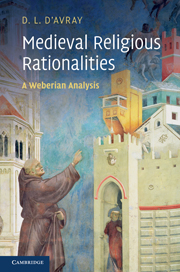Book contents
- Frontmatter
- Contents
- Preface and acknowledgements
- Abbreviations
- 1 Preliminaries
- 2 Medieval values: structures
- 3 Medieval values: dynamics
- 4 The value–instrumental interface in the Middle Ages
- 5 Formal rationality and medieval religious law
- 6 The formal–substantive interface and the dispensation system
- General conclusion
- Bibliography
- Index of manuscripts
- General index
6 - The formal–substantive interface and the dispensation system
Published online by Cambridge University Press: 05 June 2012
- Frontmatter
- Contents
- Preface and acknowledgements
- Abbreviations
- 1 Preliminaries
- 2 Medieval values: structures
- 3 Medieval values: dynamics
- 4 The value–instrumental interface in the Middle Ages
- 5 Formal rationality and medieval religious law
- 6 The formal–substantive interface and the dispensation system
- General conclusion
- Bibliography
- Index of manuscripts
- General index
Summary
A shifting borderline
Formal legal rationality and substantive (or material) rationality are not usefully defined as opposites. Drawing the line between formal and substantive considerations is itself a matter of instrumental reasoning usually shaped in its turn by values and convictions – so the leitmotif of this book recurs. Furthermore, formal and substantive rationality often have a common basis in the assumption that the formal rules are not to be identified with morality tout court.
The formal and substantive rationalities of legal procedure
This is most evidently true with procedural rules. From the second half of the twelfth century on, an increasingly formal and elaborate law of procedure was built up in the Western Church, in tandem with the massive expansion of papal law and the development of professionally staffed local ecclesiastical courts. This is not the place to go into the details of the procedure, but it was ‘complex and technical by the turn of the thirteenth century and became increasingly sophisticated and demanding during the century’. In response, we find a growing interest in ‘summary’ procedures, which dispensed with some of the formal procedural steps. Popes and canon lawyers saw the advantages of allowing formal corners to be cut if that was not prejudicial to real justice. This was a trend from formal to substantive rationality. The key period was from the mid-thirteenth to the early fourteenth century. Milestones were the canon law commentary of Innocent IV, the decree Statuta of Boniface VIII, the decree Dispendiosam of the Council of Vienne in 1311/12, and the clarificatory papal constitution Saepe.
- Type
- Chapter
- Information
- Medieval Religious RationalitiesA Weberian Analysis, pp. 150 - 163Publisher: Cambridge University PressPrint publication year: 2010

